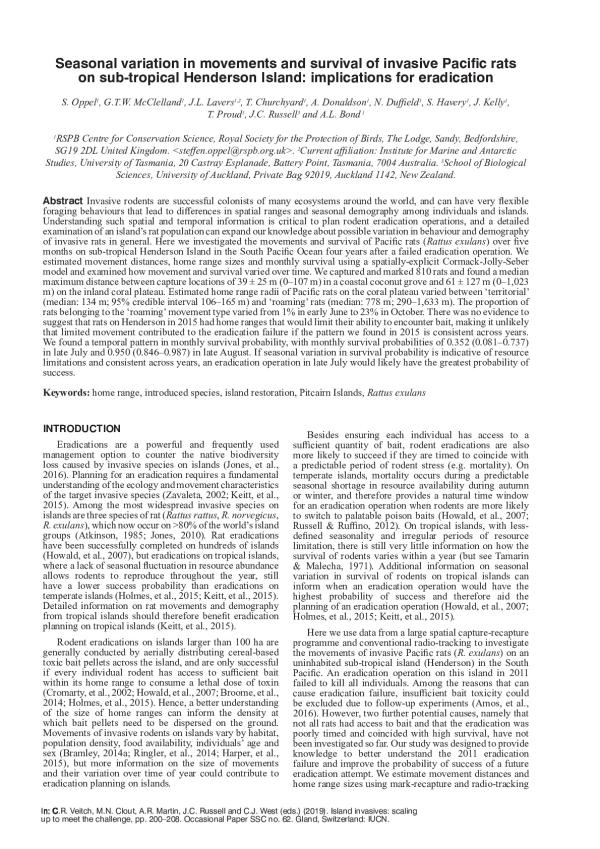Localisation
SPREP LIBRARY
Éditeur
Secretariat of the Pacific Regional Environment Programme (SPREP)
Année de publication:
2019
Lieu de publication
Apia, Samoa
Description physique:
9 p.
Numéro d'appel
[EL]
Type de contenu
Langue
English
Identifiant de dossier:
644
Ancien numéro d'identification PEIN:
82523
Notes générales
Available online
Disponible en ligne
Rubrique(s) thématique(s)
Invasive species
Résumé
Invasive rodents are successful colonists of many ecosystems around the world, and can have very flexible foraging behaviours that lead to differences in spatial ranges and seasonal demography among individuals and islands. Understanding such spatial and temporal information is critical to plan rodent eradication operations, and a detailed examination of an islands rat population can expand our knowledge about possible variation in behaviour and demography of invasive rats in general. Here we investigated the movements and survival of Pacific rats (Rattus exulans) over five months on sub-tropical Henderson Island in the South Pacific Ocean four years after a failed eradication operation. We estimated movement distances, home range sizes and monthly survival using a spatially-explicit Cormack-Jolly-Seber model and examined how movement and survival varied over time. We captured and marked 810 rats and found a median maximum distance between capture locations of 39 ± 25 m (0107 m) in a coastal coconut grove and 61 ± 127 m (01,023 m) on the inland coral plateau. Estimated home range radii of Pacific rats on the coral plateau varied between territorial (median: 134 m; 95% credible interval 106165 m) and roaming rats (median: 778 m; 2901,633 m). The proportion of rats belonging to the roaming movement type varied from 1% in early June to 23% in October. There was no evidence to suggest that rats on Henderson in 2015 had home ranges that would limit their ability to encounter bait, making it unlikely that limited movement contributed to the eradication failure if the pattern we found in 2015 is consistent across years. We found a temporal pattern in monthly survival probability, with monthly survival probabilities of 0.352 (0.0810.737) in late July and 0.950 (0.8460.987) in late August. If seasonal variation in survival probability is indicative of resource limitations and consistent across years, an eradication operation in late July would likely have the greatest probability of success.
Programme(s):
Localisation
SPREP LIBRARY
Éditeur
Secretariat of the Pacific Regional Environment Programme (SPREP)
Année de publication:
2019
Lieu de publication
Apia, Samoa
Description physique:
9 p.
Numéro d'appel
[EL]
Type de contenu
Langue
English
Identifiant de dossier:
644
Ancien numéro d'identification PEIN:
82523
Notes générales
Available online
Dossier créé: 31-May-2019
Dossier modifié: 17-Feb-2022

